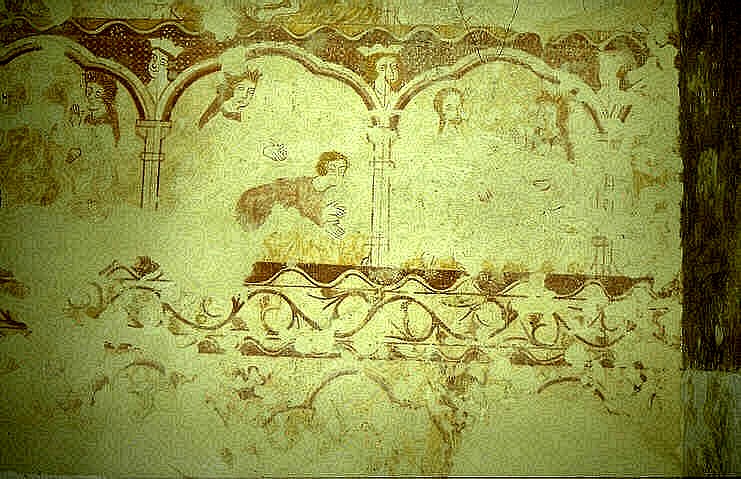Kelmscott, Oxfordshire (†Oxford) C.1280
Cain and Abel

The events of Genesis 4:8-12 are narrated in three scenes. Reading from the left, Cain and Abel stand on either side of a fire, Abel, unfortunately obscured in this photograph, to the left, and Cain to the right, his right hand raised in dismay at the rejection of his burnt-offering.
In the next scene, under the second painted trefoil arcade, the actual murder of Abel by Cain is shown. Abel, most of his figure clear, falls forward on to the ground, while Cain, reduced to head and hands only, stands to the left and above. His hands are shown in a position to strike at his brother, but the weapon he held, whether an ordinary club or the ass’s jawbone of legend (peculiarly English legend, it seems, at least earlier in the Middle Ages¹), is sadly gone. Under the right-hand arcade is the outcome of the murder, with God, his head only visible, standing to the left and confronting Cain, whose right hand is again raised, this time in denial or guilty shock, as God questions him about his missing brother.
Cain’s identity as the villain in the story is signified in these paintings by his hair, I think. It is upswept into points, contrasting with the neat and smoothly rounded hair of Abel and God.
Devils and demonic figures in medieval art frequently have this kind of hair, and by association ‘bad’ characters (perhaps including the man stoning St Stephen at nearby Black Bourton) may be shown with it too. Particularly good example of devils with upswept hair are found in the woodcuts of the 15th-century Ars Moriendi², but the tradition is much older than that.
The painting, like all those at Kelmscott, is in the North Chapel, which was completely painted once (faint traces of scenes – almost certainly also from Genesis – once above and below the story of Cain and Abel can be glimpsed in the photograph). The only remaining identifiable scenes apart from this though are the Expulsion around the north window and what I think are two scenes from an Infancy Cycle on the wall opposite the Cain and Abel scenes. Those two also have the elaborate borders visible here, including the benign-looking crowned figures apparently looking on from beyond the top edges of the scene. No specific identification for, or moral significance in, these heads has ever been found, and it may be that (for once) they are purely decorative. All those still visible are ‘young kings’, though, and the painter may be saying something about the genealogy of Christ and the procession through history of covenants with representatives of Israel until his Incarnation.
¹ The history of the jawbone as murder weapon is discussed in an interesting essay on the theme in the late Professor Meyer Schapiro’s Late Antique, Early Christian & Medieval Art, Meyer Schapiro, Selected Papers, Vol.3, Chatto & Windus, London, 1980, pp.249-265.
² e.g. as in the Arte or Craft to Lyve Well and to Dye Well published by Wynkyn de Worde in 1505. One well known example is the block-book illustration showing a dying man surrounded by waiting devils who enumerate his sins. (Reproduced in Eamon Duffy, The Stripping of the Altars, Yale, 1992, plate 118, and elsewhere).
† in page heading = Diocese